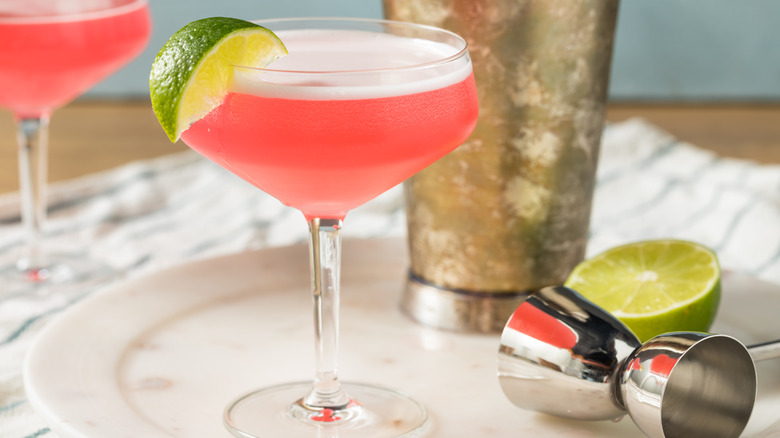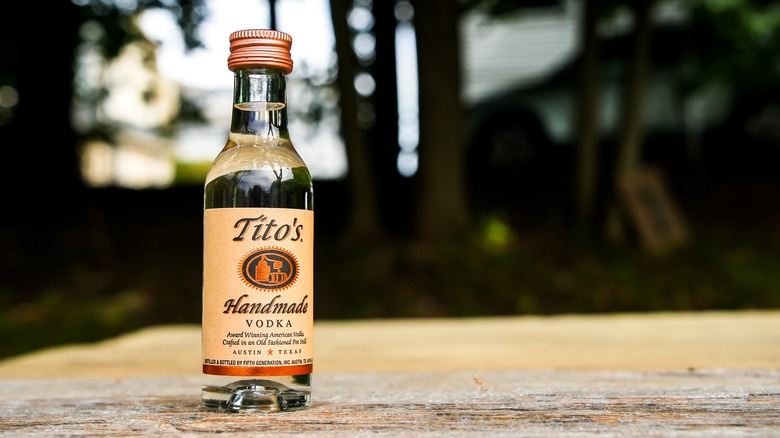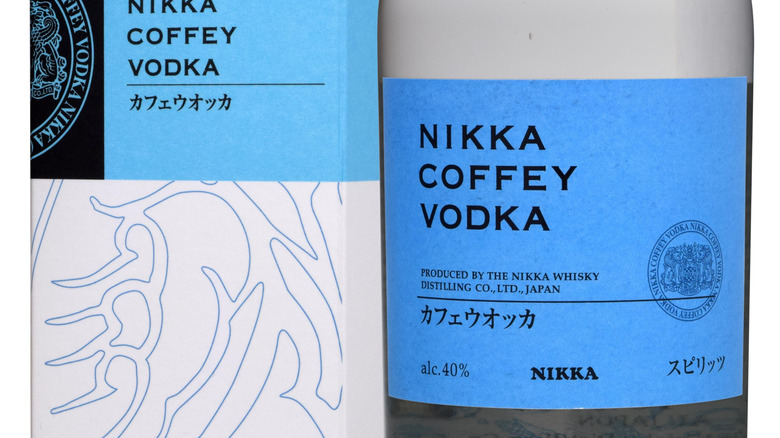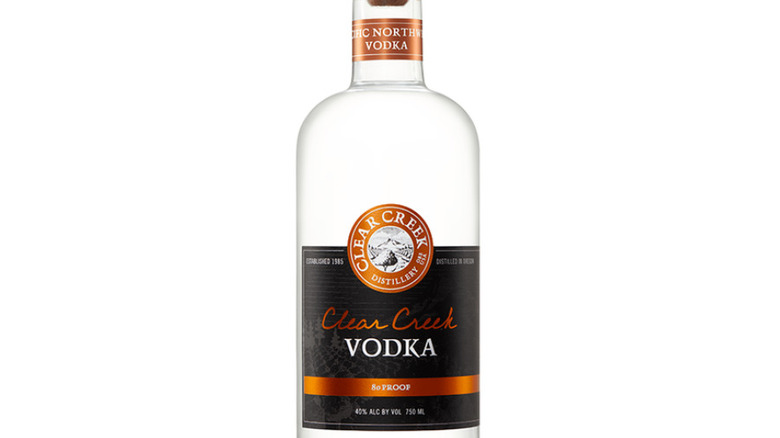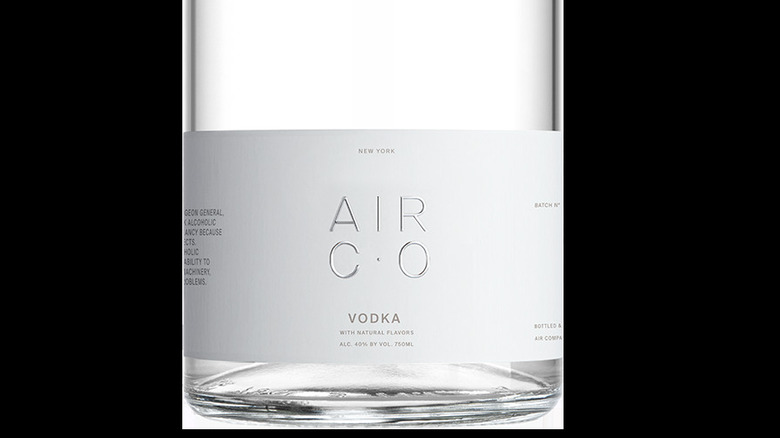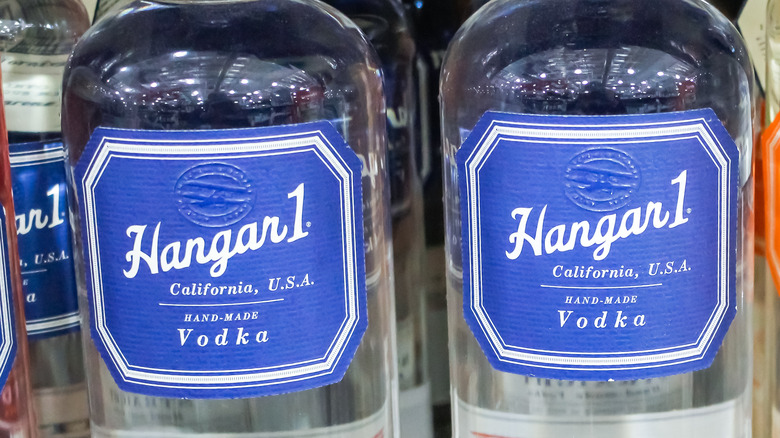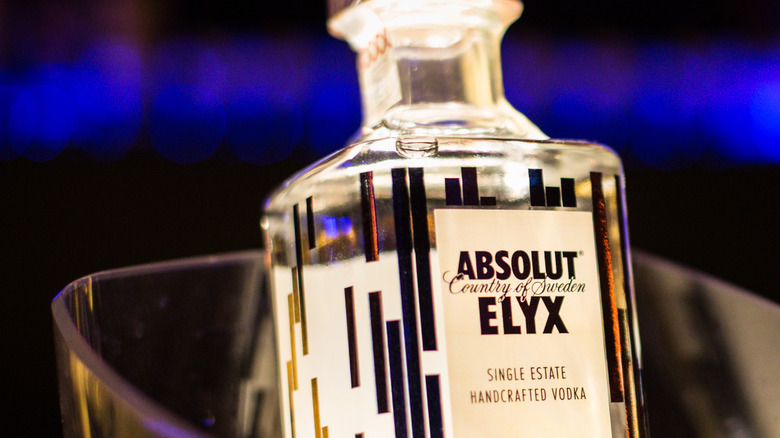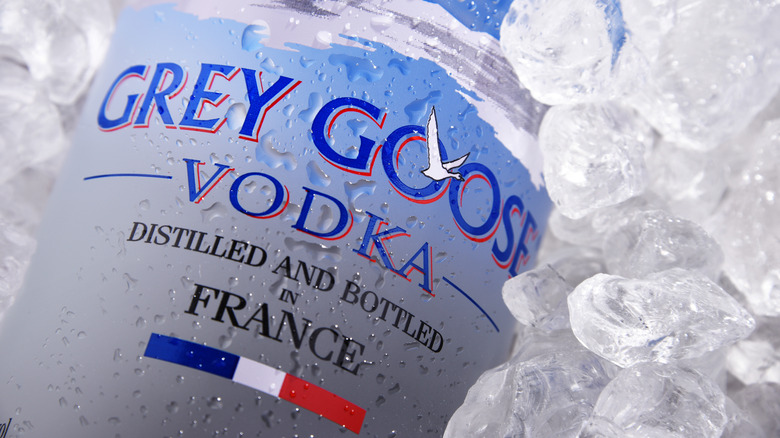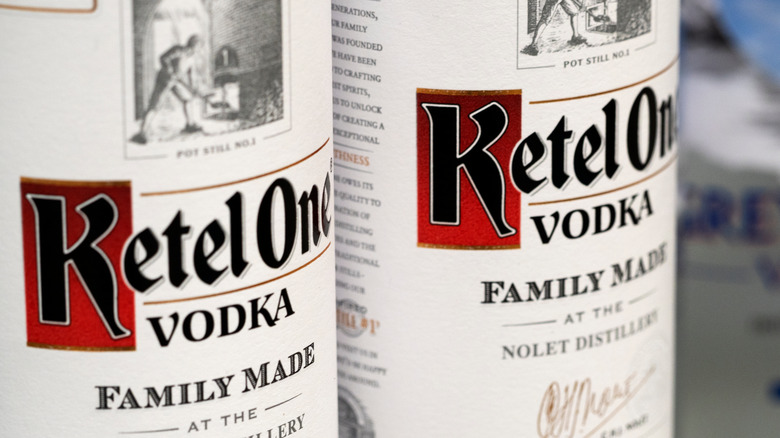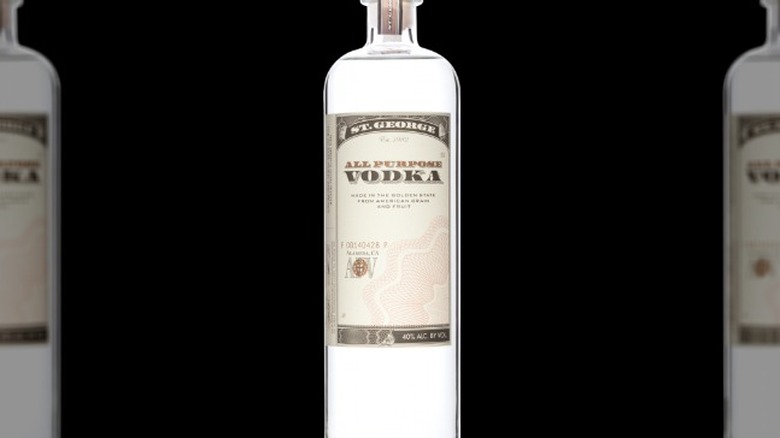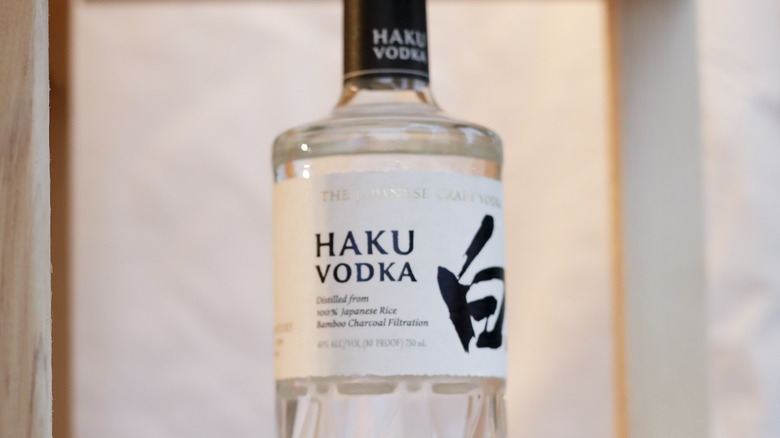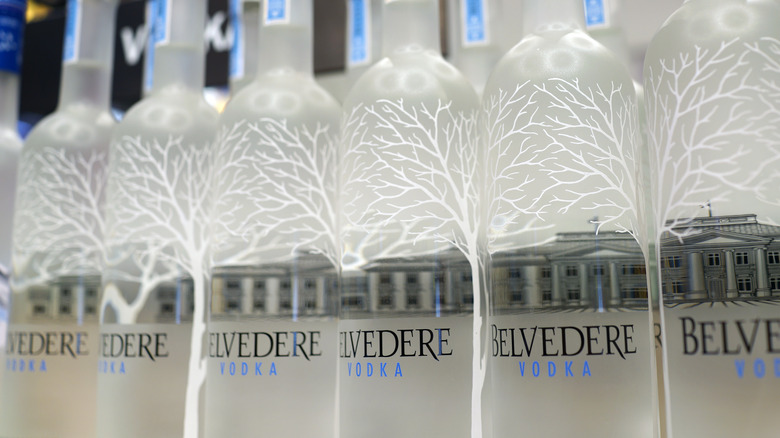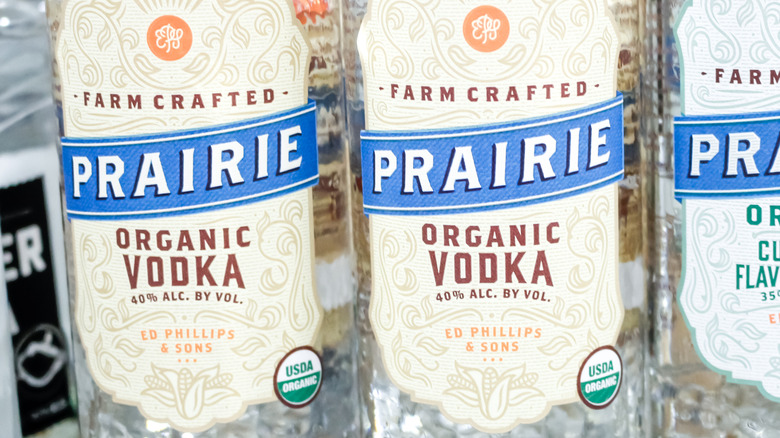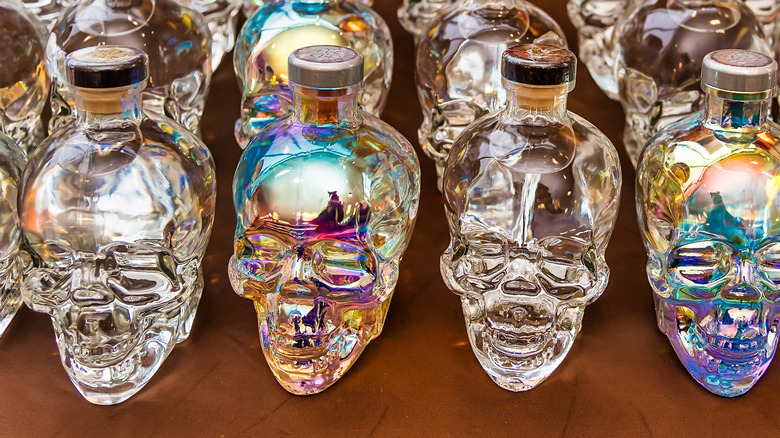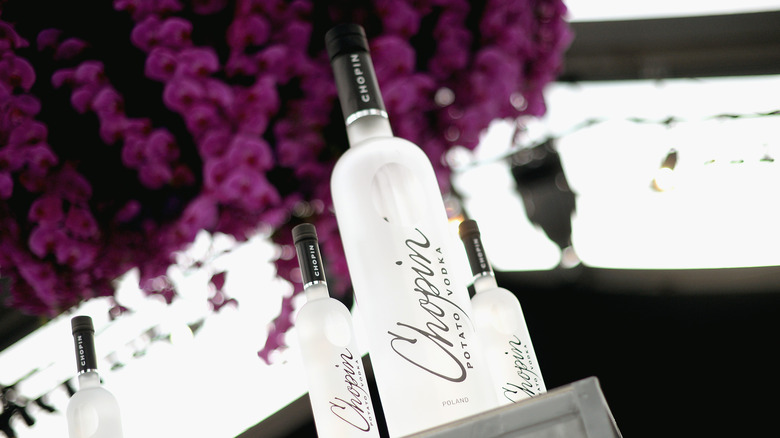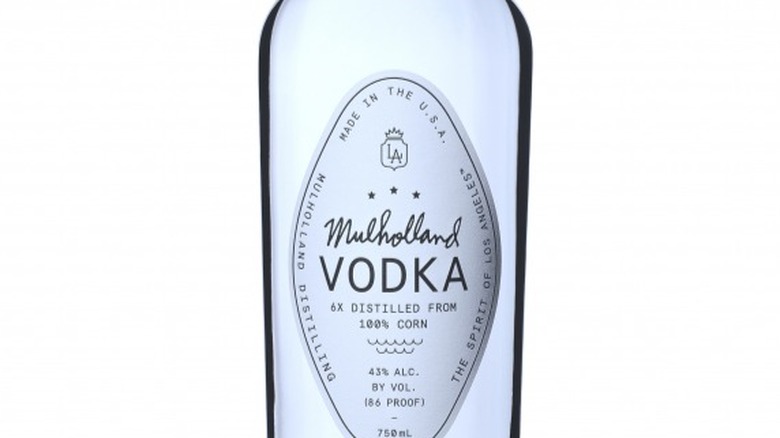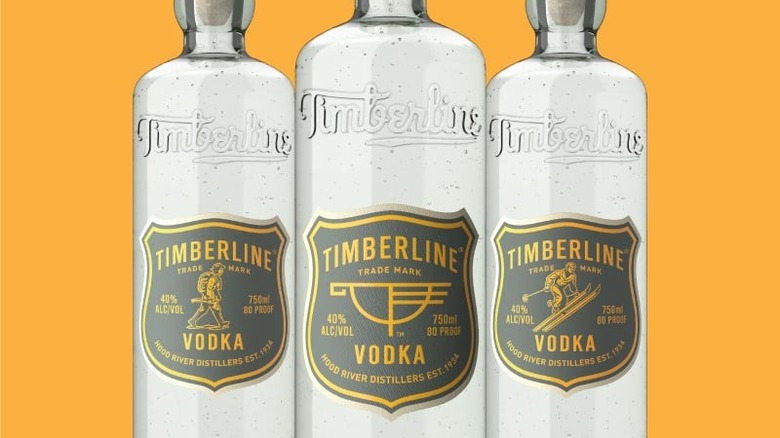16 Best Vodkas For A Cosmopolitan
Claw clips, chunky shoes, and white eyeliner aren't the only trends from the 90s making a comeback. Cocktails like the espresso martini are making a splashy comeback at bars across the country. On the heels of the caffeinated concoction is the blush-colored classic known as a cosmopolitan (or cosmo), and it's poised to reemerge as the cocktail of the moment.
The beverage — thanks to Carrie Bradshaw and the rest of the "Sex and the City" crew — has a reputation for being the basic pumpkin spice latte of the cocktail world, borrowing its specs from a daiquiri or gin gimlet. Simply composed of vodka, sweetener (triple sec or simple syrup or both), cranberry, and lime juice, the cosmopolitan is every bit as boozy as a margarita or whiskey sour.
Like the aforementioned espresso martini, the cosmopolitan is also built on a base of vodka, but finding the ideal clear spirit for your tart libation can be overwhelming if you visit your liquor store without dipping your toe into a little research first. Brett Adams, bar manager of Multnomah Whiskey Library in Portland, Oregon, and author of the upcoming cocktail guide, "Raising the Bar," urges the consumer to stay smart and believes that "expensive vodka isn't better. It's just expensive." So, to give you a leg up on your liquor aisle adventure, we've curated a list of our all-time favorite vodkas to shake up your cosmopolitan game.
Tito's Handmade Vodka
When we're in a small town, or far from a top-notch liquor store, Tito's label beacons to us as a safe and dependable foundation on which to build our cosmopolitan. Corn-based (and therefore naturally gluten-free), Tito's Vodka carries a slight note of black pepper on the palate and pairs nicely with a cosmo's cranberry juice, which also has a biting verve on the back end.
The Austin, Texas-based brand first distilled its spirit in 1995 and since then has stayed true to its roots. To this day, it still only produces its tried and true, original bottle of vodka, skipping on the flavor-infused trends of today's market. And at around $20 a bottle, Tito's proves to be a trustworthy bottle to fall back on when you don't want to reach for the top-shelf goods and spend major money on a vodka that will be mixed into a cocktail anyway.
Nikka Coffey Vodka
Branching out from their whisky roots, the Japanese brand Nikka now makes vodka (and gin) that you can fill your bar cart with. Unlike their much-lauded whisky, their vodka is still a reasonably obscure spirit due to being a relative newcomer to the market. Though the brand has been making some of the best whisky on the shelves since the 1800s, its foray into clear spirits only dates back to 2014, according to Dekanta.
A combination of both corn and malted barley (distilled separately), Nikka Coffey Vodka carries floral and stonefruit notes (great for a fruitier rendition of a cosmo) and is thankfully smooth enough to sip on straight out of the bottle. The mouthfeel of Nikka can feel a little thick, round, and noticeably creamy which complements the zing of cranberry and citrus. However, we also recommend pouring Nikka for your wintertime cosmo because of the heavy texture.
Clear Creek Vodka
A newbie out of the Pacific Northwest, Clear Creek Vodka introduced itself to drinkers back in 2019, but in the three years that have followed, the vodka has carved a place for itself in renowned bartenders' toolkits. Adams claims the spirit is "perfect if you're looking for a vodka that has a subtle flavor and great texture."
Founded in 1985, Clear Creek built its brand on pear and apple brandy before expanding its portfolio into vodka. Made from 14 different varietals of non-GMO apples grown in the Pacific Northwest, the vodka is then "cut to 80 proof with glacier-fed spring water from Mt. Hood," according to their website. Redolent with the apple aromas the vodka is distilled from, Clear Creek also sets itself apart with a gentle minerality on the tongue, making it a tasty choice for when you're in the mood for a touch of salt (via Liquor) to bring out the sour and sweet notes of a cosmopolitan.
Air Vodka
With a bottle design sleek enough to resemble a Yeezy footwear drop, Air Vodka also boasts that they're the "world's cleanest, highest quality, and most sustainable spirit," according to their website's verbiage. And while these three not-so-humble-brags are difficult to definitively prove, Air Vodka does carry a distinct hint of vanilla and floral notes as well as a crisp finish, making it the vodka of choice for the sipper wanting to lean into the cosmopolitan's sweeter components (and for those who prefer to not taste whatever spirit they're sampling).
Made simply from CO2 and water, Air Vodka captures the air we breathe and repurposes it into a quaffable spirit. This wunderkind remains somewhat of a luxury item and will run you upwards of $70 per bottle. But for special occasions — and the opportunity to talk about the innovative company — the bottle is worth the price of admission a couple of times a year.
Hangar 1 Straight Vodka
Hangar 1 Vodka, based out of Alameda, California, celebrated its 20th year distilling from a retired aircraft hangar last year and is producing some of the buzziest vodkas to hail from the Bay Area. Possibly because the vodka's derived from spent Viognier grapes (and American wheat), Hangar 1's Straight Vodka smells a little like cognac but flaunts a balanced, polished, and slightly velvety texture on the tongue.
While it's ideal for your vodka martini drinkers (due to a pleasant oily tinge to the spirit), keeping a bottle of Hangar on hand is like a Swiss army knife for your liquor cabinet — it's versatile and able to thrive in any vodka-based cocktail imaginable. As a rule, we agree with Adams' advice to stay away from Hangar 1's (or any vodka brands') flavored concoctions. Instead, reach for the unadulterated bottles — or as Adams suggests, "shake [your cosmo] with a peel of lemon to get that citrus vodka feel without actually using Absolut Citron."
Absolut Elyx
Speaking of Absolut, the Swedish brand is a standby in the world of luxury vodkas. And Absolut Elyx arrives at the party dressed in a lustrous, copper-toned bottle in reference to both its value and its distillation process using a vintage copper column. Unlike their more widely produced sister, Absolut, Absolut Elyx hails from a single estate and is a relatively young sub-category having launched in 2017 (the brand was founded a hundred years prior in 1917).
According to their website: "Thousands of copper packets are used sacrificially, removing unwanted compounds and contributing to a rich final product." For us, this vodka is a chameleon of a potion. It's neutral and nearly invisible in flavor, which allows it to take on the qualities of the components around it — in this case, cranberry and lime juice. While we would never dream of wasting the nearly $50 a bottle to serve Absolut Elyx as shots, the vodka works best in a cocktail meant to be sipped slowly.
Grey Goose Vodka
No list of vodkas would be complete without the skinny, translucent bottle of Grey Goose. Made from winter wheat in Picardie (a region known for its wheat production) and water that hails from a natural limestone well in Gensac-La-Pallue, the French vodka exhibits the terroir of the spirit perhaps more than any other widely distributed vodka on the market.
First released at the height of the cosmopolitan cocktail in 1997, Grey Goose is the vodka that most than likely had the cosmo in mind during its creation. Representative of the cosmo's reigning era, the vodka can be found at nearly every liquor store and behind the bar of every reliable cocktail counter, making it a staple when ordering the tart elixir. Just slightly sweet, Grey Goose's silky texture leaves a clean, crisp, and cutting chill on the palate and never leaves the boozy burn some bottom-shelf dwellers are known for.
Ketel One Vodka
Another standard vodka found on shelves behind the bar, Ketel One Vodka first arrived on the scene in 1983 — just after the U.S. began fully embracing vodka in their cocktails around the mid-70s, according to Atlas Obscura. Ketel One's release coincided with the era vodka officially surpassed whiskey's popularity in America, via Imbibe Magazine.
Distilled entirely from wheat in copper pots in the Netherlands, Ketel One is the Scandanavian answer to mainland European luxury vodka brands like Grey Goose, Monopolowa, and Belvedere. Completely unoffensive and readily available, Ketel One is another fallback for anyone searching for a stalwart vodka at a bar they're unfamiliar with. Named after the oldest copper pot in their distillery (Distilleerketel #1), Ketel One tastes lightly toasted and has a slight spice that evens out the acidic slap from the ingredients of a cosmopolitan. Its citrusy nose complements the lime juice in near-perfect harmony.
St. George All-Purpose Vodka
Probably better known for their (admittedly great) gins, St. George Distillery was launched in 1982 after founder and head distiller, Jorg Ruff, was inspired to fill the void in craft American distilleries. At the time, according to their website, less than 20 distilleries called the new world home and Ruff wanted to "blaze the trail for artisan distillers" in America.
First focusing on brandy, the company began to produce their highly regarded gin line in 2011, and in 2015, their vodkas followed. By distilling the brand's flagship pear brandy with grains, St. George's vodka has a noticeable whiff of pear on the nose, but on the palate, it translates a bit floral with hints of fresh vanilla spice. We're most excited by St. George's All-Purpose Vodka because of its light, soft, and summery mouthfeel, making it our vodka of choice when it's over 80 degrees out and we're in need of a bright beverage.
Haku Vodka
Another Japanese whisky brand branching out into the clear spirits universe, Suntory's path into the world of vodka comes in the form of Haku Vodka. Like their coveted whiskys, Suntory prides itself on Haku Vodka's meticulous manufacturing process. Made entirely from Japanese rice gains (which are fermented with koji) and filtered through charcoal, this Japanese vodka is undeniably clean and even bright on the palate — a truly delicious sipper on its own or mixed into a cocktail.
Haku, meaning both "white" and "brilliant" in Japanese, has a dry, almost-austere taste on the tongue, making it perfect for a cosmopolitan cocktail enjoyed right before a light meal of crudos or crudites. Only on the market since 2018, Haku signals vodka's permanent importance on the cocktail scene. Suntory's commitment to Haku (and its delicious gin cousin, Roku) lends a sense of earnestness to a spirit that is too often scoffed at by bartenders and cocktail aficionados.
Belvedere Vodka
This iconic bottle is synonymous with extravagance and bills itself as "the world's first super-premium vodka." Hailing from Poland, Belvedere first appeared on shelves in 1993 and is made from "Dankowski rye, a heritage grain with genetics that pre-date intensive agricultural production and scientific plant breeding," via VinePair.
The vodka pours almost impossibly clear, and like the bottle it's sold in, does in fact taste elegant, with obvious flickers of vanilla and wafts of rye leftover from the distilling process. Though they've branched out into even higher-end bottles like the new-ish (2003) Belvedere Intense (which is also made with rye before being filtered through charcoal), we prefer their classic bellwether bottle for our cosmopolitan. The spicy whispers of white pepper marry an undiluted and unsweetened cranberry juice perfectly while the more costly bottle of their line is imperceptible on the palate and a little flimsy to stand up to a cocktail's other ingredients.
Prairie Vodka
The only Midwestern vodka on our list, Minnesota's Prairie Vodka is made from organic, non-GMO corn and claims to be the "no. 1 organic spirits brand in America." Though their unassuming, country-esque name points to their humble beginnings, since Prairie Vodka's debut in 2008, the company has racked up an armload of awards including the "2020 Consumer's Choice" from Sip Awards and a gold medal in the World Spirits Competition in 2017.
For us, the vodka functions as a true workhorse in our home bar and tastes great in everything from a briny martini, an ultra-sweet lemon drop, and a nearly meal-worthy bloody mary. Though it carries a slight tinge of corn, the flavor doesn't clash with the remaining ingredients in a cosmopolitan letting the overall quality of the drink shines through. Unlike other vodkas on the market (and even on this list), the spirit boasts a vivid depth of flavor — a pleasing addition to a cocktail that's meant to be nursed.
Crystal Head Vodka
Ignoring Crystal Head's garish and clunky bottle (yes, it's shaped like a human skull and is unfortunately hard to hold/pour from), we have to admit that the spirit lurking inside the pirate-esque vessel is actually pretty good. Made from Canadian corn that's been distilled four times into a neutral grain spirit and mixed with the clean waters of Newfoundland, the vodka endures three more rounds of filtration through semi-precious crystals.
While we are not sure we can pick up on the Herkimer diamonds that liquid is filtered through, we do think the vodka is more than the cheap thrill we judged it as. Founded by SNL alumn, Dan Akroyd, the elixir tastes slightly like peaches and is a team player when thrown into a cocktail. Smooth but still flavorful, the vodka, founded in 2008, has stuck around longer than many celebrity novelty spirits. Our only main qualm is the tacky bottle.
Chopin Vodka
Named after the Romanic composer, Frederic Chopin, this Polish vodka makes good on its title by conveying a symphony of subtle flavors. Both full-bodied and light on its toes, Chopin Vodka carries hints of green apple skins and a nutty aroma, making it ideal for a fruit-forward cocktail like a cosmopolitan. Plus, unlike a vodka with deeper, more boisterous tasting notes, Chopin's ease on the palate plays nicely with weightier elements like the sometimes dense cranberry juice (which should be used with a gentle touch).
Perhaps because of its delicate balance of potatoes, rye, yeast, and purified water, Chopin's end product tastes pristine but still maintains a personality of its own. First released in 1992, Chopin's heritage dates back to the first wave of luxury vodkas along with Grey Goose and Absolut; however, if we're picking which bottle to reach for on the highest shelf of our local liquor store, Chopin wins hands down.
Mulholland Vodka
Named after the ritzy street sitting above Los Angeles, Mulholland Vodka is actually a collaboration between two states. First distilled and bottled in Missouri, the corn-based vodka is then shipped to Ukiah, California to be bottled. As splashy as a Hollywood step and repeat, Mulholland succeeds in delivering a vodka fit for the stars without breaking the bank (it averages around $22 a bottle).
Launched in 2016, Mulholland has become a staple of the Angeleno bar scene at hotspots like Otium and Here's Looking at You. Ultra clean tasting due to its double filtration with charcoal, the vodka's essence is light and brief on the palate, but generous for cocktails using a citrus like our cosmopolitan. Smelling lightly of mint, we suggest pouring Mulholland Vodka into a shaker filled with an herby-infused simple syrup like mint, rosemary, or thyme for a refreshing rendition of the fuschia-hued cosmo cocktail.
Timberline Vodka
Timberline Vodka, the newest vodka on our list, hails from Mt. Hood National Forest, outside of Portland, Oregon. It's attempting to rebrand the vodka experience from a night-out beverage to an outdoorsy drink fit for the camping class of the Pacific Northwest (PNW). Made from fruit (apples), grains, and natural spring water, Adams says Timberline Vodka is "great for people looking for a more traditional vodka that is actually handmade."
Like Adams, we appreciate the vodka most in a cocktail that isn't trying to reinvent the wheel. Timberline Vodka feels ultra-cold on the tongue and is the vodka we crave in the dead of winter when we're yearning for a little pick-me-up but can't make it to the ski lifts. And since nearly 7% (via Oregon Encyclopedia) of the entire world's cranberries are harvested from the PNW (from the months of October to December), we look to Timberline when crafting a seasonal interpretation of Carrie Bradshaw's favorite drink.
